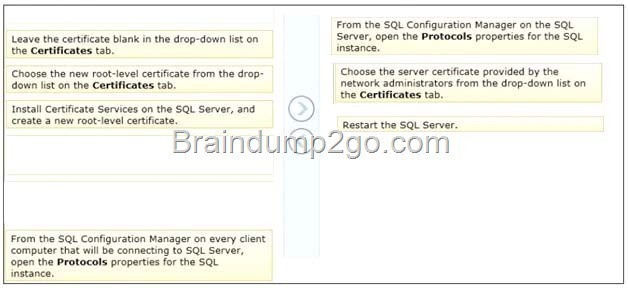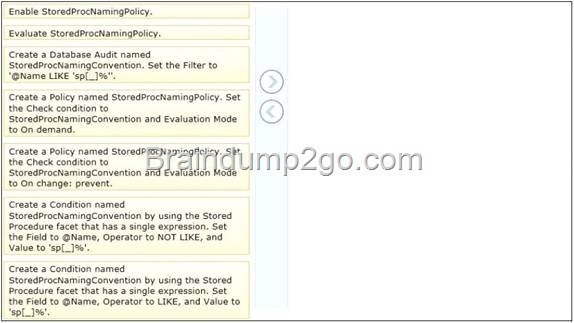QUESTION 1
You administer a Microsoft SQL Server 2012 database. The database has a table named Customers owned by UserA and another table named Orders owned by UserB.
You also have a stored procedure named GetCustomerOrderInfo owned by UserB. GetCustomerOrderInfo selects data from both tables.
You create a new user named UserC.
You need to ensure that UserC can call the GetCustomerOrderInfo stored procedure.
You also need to assign only the minimum required permissions to UserC.
Which permission or permissions should you assign to UserC? Choose all that apply.
A. The Select permission on Customers
B. The Execute permission on GetCustomerOrderInfo
C. The Take Ownership permission on Customers
D. The Control permission on GetCustomerOrderInfo
E. The Take Ownership permission on Orders
F. The Select permission on Orders
Answer: AB
Explanation:
The question seems to be missing something. Or the original answer is incorrect. I’ve changed it to what I believe to be the correct answer. The original answer included “The Select permission on Orders.”, but due to ownership chaining, you would only need to give Execute permissions to UserC to access the Orders table since UserB is the owner.
(BF) – need to test this
Reference:
http://msdn.microsoft.com/en-us/library/ms188676.aspx
http://stackoverflow.com/questions/2212044/sql-server-how-to-permission-schemas
http://sqlservercentral.com/blogs/steve_jones/2012/03/14/ownership-chains-in-sql-server
QUESTION 2
You administer a Microsoft SQL Server 2012 database named ContosoDb. The database contains a table named Suppliers and a column named IsActive in the Purchases schema.
You create a new user named ContosoUser in ContosoDb. ContosoUser has no permissions to the Suppliers table.
You need to ensure that ContosoUser can delete rows that are not active from Suppliers.
You also need to grant ContosoUser only the minimum required permissions.
Which Transact-SQL statement should you use?
A. GRANT DELETE ON Purchases. Suppliers TC ContosoUser
B. CREATE PROCEDURE Purchases.PurgelnactiveSuppliers WITH EXECUTE AS USER = ‘dbo’
AS
DELETE FROM Purchases.Suppliers WHERE IsActive = 0
GO
GRANT EXECUTE ON Purchases.PurgelnactiveSuppliers TO ContosoUser
C. GRANT SELECT ON Purchases.Suppliers TO ContosoUser
D. CREATE PROCEDURE Purchases. PurgeInactiveSuppliers
AS
DELETE FROM Purchases.Suppliers WHERE IsActive = 0
GO
GRANT EXECUTE ON Purchases. PurgeInactiveSuppliers TO ContosoUser
Answer: B
Explanation:
http://msdn.microsoft.com/en-us/library/ms188354.aspx
http://msdn.microsoft.com/en-us/library/ms187926.aspx
QUESTION 3
You use a contained database named ContosoDb within a domain.
You need to create a user who can log on to the ContosoDb database.
You also need to ensure that you can port the database to different database servers within the domain without additional user account configurations.
Which type of user should you create?
A. User mapped to a certificate
B. SQL user without login
C. Domain user
D. SQL user with login
Answer: C
QUESTION 4
You administer a Microsoft SQL Server 2012 database that has multiple tables in the Sales schema. Some users must be prevented from deleting records in any of the tables in the Sales schema.
You need to manage users who are prevented from deleting records in the Sales schema.
You need to achieve this goal by using the minimum amount of administrative effort.
What should you do?
A. Create a custom database role that includes the users. Deny Delete permissions on the Sales schema
for the custom database role.
B. Include the Sales schema as an owned schema for the db_denydatawriter role. Add the users to the
db_denydatawriter role.
C. Deny Delete permissions on each table in the Sales schema for each user.
D. Create a custom database role that includes the users. Deny Delete permissions on each table in the
Sales schema for the custom database role.
Answer: A
QUESTION 5
You are the lead database administrator (DBA) of a Microsoft SQL Server 2012 environment. All DBAs are members of the DOMAIN\JrDBAs Active Directory group.
You grant DOMAIN\JrDBAs access to the SQL Server.
You need to create a server role named SpecialDBARole that can perform the following functions:
* View all databases.
* View the server state.
* Assign GRANT, DENY, and REVOKE permissions on logins.
You need to add DOMAIN\JrDBAs to the server role.
You also need to provide the least level of privileges necessary.
Which SQL statement or statements should you use? Choose all that apply.
A. CREATE SERVER ROLE [SpecialDBARole] AUTHORIZATION setupadmin;
B. ALTER SERVER ROLE [SpecialDBARole] ADD MEMBER [DOMAIN\JrDBAs];
C. CREATE SERVER ROLE [SpecialDBARole] AUTHORIZATION securityadmin;
D. GRANT VIEW DEFINITION TO [SpecialDBARole];
E. CREATE SERVER ROLE [SpecialDBARole] AUTHORIZATION serveradmin;
F. GRANT VIEW SERVER STATE, VIEW ANY DATABASE TO [SpecialDBARole];
Answer: BCF
QUESTION 6
Drag and Drop Question
You administer a Microsoft SQL Server 2012 database. All database traffic to the SQL Server must be encrypted by using secure socket layer (SSL) certificates or the connection must be refused. Network administrators have deployed server certificates to the Windows store of all Windows servers on the network from a trusted Certificate Authority. This is the only Certificate Authority allowed to distribute certificates on the network.
You enable the Force Encryption flag for the MSSQLServer protocols, but client computers are unable to connect. They receive the following error message:
“A connection was successfully established with the server, but then an error occurred during the pre-login handshake, (provider: SSL Provider, error: 0 – The certificate chain was issued by an authority that is not trusted.) (Microsoft SQL Server)”
You notice the following entry in the SQL Server log:
“A self-generated certificate was successfully loaded for encryption.”
You need to configure SQL Server to encrypt all client traffic across the network.
You also need to ensure that client computers are able to connect to the server by using a trusted certificate.
Which three actions should you perform in sequence? (To answer, move the appropriate actions from the list of actions to the answer area and arrange them in the correct order.)
![clip_image002_thumb_thumb_thumb_thum[1]_thumb_thumb_thumb_thumb clip_image002_thumb_thumb_thumb_thum[1]_thumb_thumb_thumb_thumb](http://examgod.com/l2pimages/c5f8de618687_8E2F/clip_image002_thumb_thumb_thumb_thum1_thumb_thumb_thumb_thumb_thumb.jpg)
Answer:

QUESTION 7
You administer a Microsoft SQL Server 2012 database that has Trustworthy set to On.
You create a stored procedure that returns database-level information from Dynamic Management Views.
You grant User1 access to execute the stored procedure.
You need to ensure that the stored procedure returns the required information when User1 executes the stored procedure.
You need to achieve this goal by granting the minimum permissions required.
What should you do? (Each correct answer presents a complete solution. Choose all that apply.)
A. Create a SQL Server login that has VIEW SERVER STATE permissions.
Create an application role and a secured password for the role.
B. Modify the stored procedure to include the EXECUTE AS OWNER statement.
Grant VIEW SERVER STATE permissions to the owner of the stored procedure.
C. Create a SQL Server login that has VIEW SERVER STATE permissions.
Modify the stored procedure to include the EXECUTE AS {newlogin} statement.
D. Grant the db_owner role on the database to User1.
E. Grant the sysadmin role on the database to User1.
Answer: BC
Explanation:
According to these references, this answer looks correct.
References:
http://msdn.microsoft.com/en-us/library/ms187861.aspx http://msdn.microsoft.com/en-us/library/ms191291.aspx
QUESTION 8
You are migrating a database named Orders to a new server that runs Microsoft SQL Server 2012. You attempt to add the [Corpnet\User1] login to the database. However, you receive the following error message:
“User already exists in current database.”
You need to configure the [Corpnet\User1] login to be able to access the Orders database and retain the original permissions.
You need to achieve this goal by using the minimum required permissions.
Which Transact-SQL statement should you use?
A. DROP USER [User1];
CREATE USER [Corpnet\User1] FOR LOGIN [Corpnet\User1];
ALTER ROLE [db_owner] ADD MEM3ER [Corpnet\User1];
B. ALTER SERVER RCLS Isysadmin] ADD MEMBER [Corpnet\User1];
C. ALTER USER [Corpnet\User1] WITH LOGIN [Corpnet\User1];
D. ALTER ROLE [db owner] ADD MEMBBR [Corpnet\User1];
Answer: C
QUESTION 9
You administer a Microsoft SQL Server 2012 database.
You configure Transparent Data Encryption (TDE) on the Orders database by using the following statements:
You attempt to restore the Orders database and the restore fails.
You copy the encryption file to the original location. A hardware failure occurs and so a new server must be installed and configured. After installing SQL Server to the new server, you restore the Orders database and copy the encryption files to their original location. However, you are unable to access the database.
You need to be able to restore the database.
Which Transact-SQL statement should you use before attempting the restore?
![clip_image0024_thumb_thumb_thumb_thu[2]_thumb_thumb_thumb_thumb clip_image0024_thumb_thumb_thumb_thu[2]_thumb_thumb_thumb_thumb](http://examgod.com/l2pimages/c5f8de618687_8E2F/clip_image0024_thumb_thumb_thumb_thu2_thumb_thumb_thumb_thumb_thumb.jpg)
A. Option A
B. Option B
C. Option C
D. Option D
Answer: C
QUESTION 10
Drag and Drop Question
You administer a Microsoft SQL Server 2012 server that has multiple databases.
You need to ensure that users are unable to create stored procedures that begin with sp_.
Which three actions should you perform in sequence? (To answer, move the appropriate actions from the list of actions to the answer area and arrange them in the correct order.)

Answer:
![clip_image0028_thumb_thumb_thumb_thu[1]_thumb_thumb_thumb_thumb clip_image0028_thumb_thumb_thumb_thu[1]_thumb_thumb_thumb_thumb](http://examgod.com/l2pimages/c5f8de618687_8E2F/clip_image0028_thumb_thumb_thumb_thu1_thumb_thumb_thumb_thumb_thumb.jpg)
Braindump2go New Updated Microsoft 70-462 Exam Questions and Answers Free Download: http://www.braindump2go.com/70-462.html